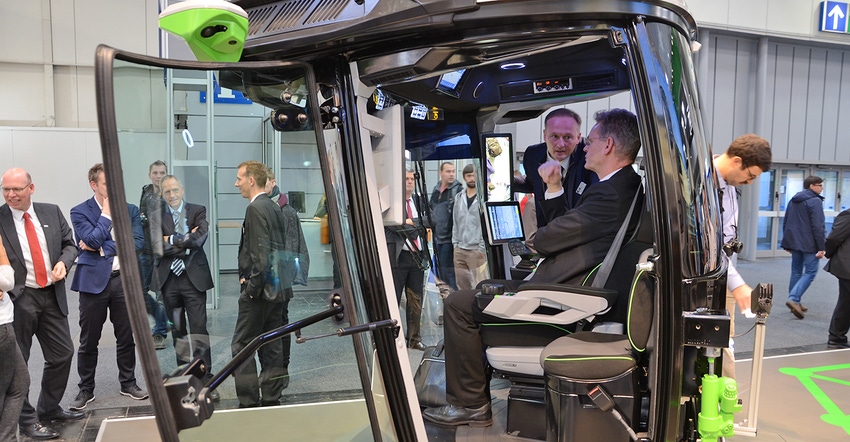December 13, 2017

Why does a combine or tractor cab look the way it does? The design of the operator station in any piece of equipment has evolved since machinery first came on the scene in agriculture. Judging from the concept approaches from Agritechnica, manufacturers and engineers have some new ideas ahead which may, or may not, see the field someday.
First, visibility has long been a challenge for engineers working to provide users a workable environment. More glass has been helpful, as has the idea that a cab can be wider and deeper, providing a much more open field. The innovation of the “training seat” in the 1980s offers a bigger platform as well.
Those are small changes compared to the ideas engineers are playing with. Here are some ideas seen at the big German show that may come to a cab near you someday.
What you see
The rise of durable compact cameras is changing the potential for what you can see on the monitor in your cab. A single monitor could eventually give you a 360-degree view of the machine you’re using for a quick check in the field or the yard.
More interactive monitor designs are in the works. Touch-screen monitors are now common, and current major equipment makers do offer a range of features (including camera interfaces) for the monitors many farmers are using now.
Earlier in 2017, New Holland showed a concept tractor at the Farm Progress Show with a wide-screen monitor that allowed three image areas in a single, well-placed location. The concepts seen at Agritechnica (including that New Holland concept machine) showed other ideas, as the use of monitors with machine data becomes more graphical and intuitive.
One area that may also get attention is the rearview mirror. Those big support arms with mirrors 6 feet from the cab do provide a nice view — but not when it’s late at night, or in dusty conditions. Replacing those mirrors with cameras outside, and well-placed, in-cab vertical monitors inside provides much better visibility. Note that the cameras not only provide a wider view during the day, but also have night vision settings that give you a much-enhanced view during the wee hours of the morning when you’re trying to finish up one more field. It’s a feature that many farmers may find essential for operation in the future.
One thing missing
In the concept cabs encountered at Agritechnica — one from Continental and the other from a consortium of vendors — there was a common design feature: maximum forward visibility in the cab, due the fact that the steering wheel had been removed.
In fact, the steering wheel wasn’t gone, but had been situated on the left arm of the operator seat, providing a wide-open view forward.

GOODBYE, STEERING WHEEL: Farmers may lose a familiar item in the cab someday — the steering wheel. The smaller armrest wheel becomes the tool for steering the vehicle when not using autosteering in the field.

Today’s machines don’t steer the same as your older machines. Usually they’re drive-by-wire systems, where you steer the wheel and an electric impulse goes to a pump and independent steering linkage that makes the turn happen. So why keep the steering wheel in that big tower right in front of you?
Some have opined that steering will be replaced by a joystick. Two of the concepts at Agritechnica showed something different — that smaller wheel on the arm of the seat. Consider that during operation, new machines mainly steer themselves and that steering wheel is less used than in the past. So why should it be out front?
Turing a big machine with that little wheel, or perhaps a joystick, in the future may take a little training, if machinery makers move down that design road.
Innovations come from many locations. The Continental concept cab is an engineering exercise showing off the company’s expertise in electronics and other operator systems. The concept cab project involves a range of vendors, from Grammer Seats to Bosch Electronics and more. That design exercise showed off a wide range of features, including an enhanced operator seat designed for maximum comfort (including massage) and ultra-bright LED lighting for night visibility.
Concepts have a “sky’s the limit” approach to design, but those on display at Agritechnica were using off-the-shelf tools that could be available to equipment designers today. As new machines come to market, it will be interesting to see what innovations engineers bring to the cab.
About the Author(s)
You May Also Like






